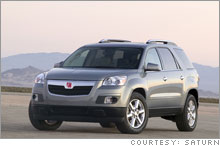Filling the minivan gapUgly and unloved, theses people movers are an endangered species. What is going to replace them?NEW YORK (Fortune) -- All the research says the functional, easy-to-drive minivan is unloved. Despite its utility and practicality, it can't shake its image as a suburban people mover. Drivers want to look as if they've just been crossing the Sahara, not the parking lot at Wal-Mart, and minivans don't fill the bill. Both General Motors and Ford have decided to let their minivan lines expire without renewing them, leaving the market to Chrysler, which invented the minivan, and the Asian imports, who made it better.
But eliminating a model line disappoints a big chunk of customers who may really need to carry seven or eight people on occasion and don't want a stretch limo or a Hummer to do it in. Here's how one automaker, GM, is closing the minivan gap at its Saturn brand. Saturn has been selling an unsuccessful minivan, the often-ignored Relay. It's a nearly identical cousin to the truly forgettable Chevrolet Uplander, Buick Terraza and Pontiac Montana . All of GM's minivans are based on a fundemental design that was intended for use in Europe as well as the U.S. For that reason, GMs minivans suffered from being too narrow. Good for squeezing through tiny European streets, bad for squeezing in Little Leaguers. GM (Charts) had tried to disguise the design's minivan genes by lengthening the front engine compartment to give it a nose, but it couldn't do anything about the sliding rear doors that scream "soccer mom." So the Relay, along with the rest of them, is going away. In its place, Saturn is launching a new vehicle in 2007 that looks like a hairy-chested SUV - aggressive front end, flared wheel arches, no sliding doors -but retains much of the functionality of a minivan. Called Outlook, it is part of an emerging product segment known as crossovers - vehicles that resemble SUVs but are engineered for the way most people really use their cars, crossing speed bumps and not the Zambezi. Saturn is a couple of years late to the mid-size crossover party. Already arrived are Ford's (Charts) Freestyle and Chrysler's (Charts) Pacifica, the Honda (Charts) Pilot and Toyota (Charts) Highlander. The Outlook is the first vehicle to be built off GM's new Lamda platform. It is also one of the first new models to receive the full attention of GM's current management, notably vice chairman and product boss Bob Lutz, and, as such, will be an important test of whether GM can build vehicles that people actually want to buy. Success of the Outlook will also signal whether GM can revive the moribund Saturn franchise, which has strayed from its original manufacturing home in Spring Hill, Tenn. and original features, like plastic body panels. An improvement on the minivan? What distinguishes the Saturn Outlook from its competitors is that it's newer and arguably handsomer; it's big and beefy like an NFL linebacker. All Outlooks come with three rows of seats. The usually inaccessible third row is made easier to reach with a nifty feature that allows you to slide the second row further forward than usual because the seat cushion flips up at the same time. Still, you wouldn't want to send your arthritic grandmother back there. Compared to the old Relay, the Outlook is voluminous. Although it is four inches shorter, it claims to contain 153.6 cubic feet of space vs. 147 cubic feet for the van. The engine is smaller - 3.6 liter vs. 3.9 - but newer, and so is the transmission: a six-speed automatic that provides smoother shifts. All of these improvements, though, are strategically designed to drive up the Outlook's weight - 4955 pounds with all-wheel drive, nearly 600 pounds more than the front-wheel-drive Relay. The avoirdupois takes just a slight toll on fuel economy. With all-wheel-drive, the Outlook gets 17 miles per gallon in town, 24 mpg on the highway vs. 18/25 for the Relay. A front-wheel-drive Outlook gets 18/26, just slightly better than the Relay in highway driving. But on the road, those pounds seem to melt away. The Outlook drives smaller than it looks. Acceleration is brisk (no numbers are available yet), the steering is well-balanced and the handling is surprisingly responsive. You don't feel like you're in a sport sedan, but you won't get that lumbering minivan sensation either. The view from the driver's seat is enhanced by one of GM's new-look instrument panels that is both handsome and informative. According to Saturn, the price of a nicely equipped Outlook will run you $35,695. Since Saturn dealers still observe the brand's no haggle policy, you won't have much room to negotiate. If it's any consolation, similar versions from GMC and Buick that are coming later in the year will probably cost more. So if you need to haul a lot of people and gear around, and can't stand being seen in a minivan, the Outlook may be the car for you. But don't forget - this is a big vehicle, as the fuel economy numbers indicate. Americans tend to buy cars based on their peak usage - family vacations - and forget about all those trips to the CVS the rest of the year with only one or two people on board. It is something to think about when you're moving two and a half tons of automobile into your garage. It's also something for GM to think about as it works to make Outlook and its Lamda siblings a success. __________________ |
|

